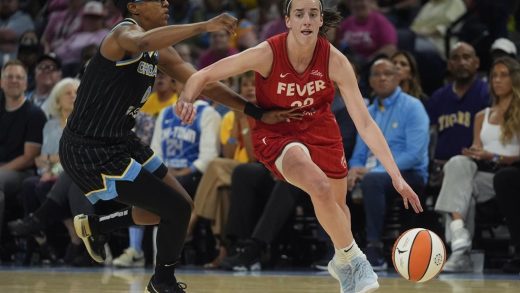:format(webp)/https://www.thestar.com/content/dam/thestar/entertainment/music/2023/01/12/doug-and-the-slugs-and-me-chronicles-80s-vancouver-ska-infused-pop-band/dougslug1.jpg)
They were a Canadian phenomenon. But to a future Vancouver director he was just the next door neighbour.
When the 90-minute chronicle “Doug and the Slugs and Me” premieres Sunday on CBC and CBC Gem at 8 p.m., director Teresa Alfeld will have shed light not only on the backstory and fate of the quirky Vancouver ska-infused pop band that carved their own niche into the Canadian musical tundra, but revealed some of her own.
That’s because as a kid and young teenager growing up in the ‘90s, Alfeld lived next door to the Bennetts and was best pals with Doug’s daughter Shea, until that friendship waned as both grew older.
So was it a healing journey for the director?
“Very much so,” Alfeld responded from Vancouver.
Alfeld said she and her producer John Bolton didn’t set out to make a film that included her personal relationships: she had used Doug and the Slugs songs for her first documentary, “The Rankin File: Legacy Of A Radical” — about 1986 Vancouver mayoral candidate Harry Rankin — and was shocked at how favourable public response was to the music used in her film.
“So John and I thought, ‘this was an obvious film to make — the story of Doug and the Slugs,’” Alfeld explained. “But as we got into production, it became pretty apparent pretty quickly that for me to make this film, I’d have to insert myself into the story and bring that shared history and perspective into it.
“Ultimately, we wound up with a film that was very healing and very cathartic to make.”
Of course, the film’s main plot focuses on the history of the mid-’80s band known as Doug and the Slugs, perpetrators of such Canadian radio and turntable classics as “Too Bad,” “Making It Work,” “Day By Day,” “Who Knows How To Make Love Stay,” and “Tomcat Prowl.”
“Cognac & Bologna” 1980.
Canadian, because despite their best efforts to make it internationally, including releasing an album or two in the U.S. and Australia and appearing on such hip talk shows of the time as “Arsenio Hall” and “Alan Thicke,” Bennett and his Slugs — guitarists John Burton and Rick Baker, keyboardist Simon Kendall, bass player Steve Bosley and drummer John “Wally” Watson — didn’t succeed.
Here, however, it was a different story: scoring a gold record for their debut album “Cognac and Bologna” and becoming must-see touring sensations across Canada. Their quirky and humorous videos built them a substantial and loyal following to the point where they would frequently fill the late and lamented Ontario Place Forum in Toronto, and they were deeply admired for their talent and drive, having largely achieved success as an independent act with a label distribution deal.
Much of that drive and singlemindedness to succeed is revealed in Alfeld’s portrayal of the head Slug, Doug Bennett, the Toronto-born graphic designer who relocated to Vancouver, assembled the band and ran versions of it until his death from complications related to alcohol abuse in 2004.
Bennett’s urge to dominate was both a blessing and a curse.
“Doug’s desire for control was incredibly beneficial and helpful,” Alfeld acknowledged. “He was incredibly driven; incredibly ambitious. He set his goals astoundingly high. And he expected everyone to work to his standard.
“It didn’t work in many ways, in the sense that he truly did want to control everything and make sure he had his hand on all decisions. I think that the story of Doug and the Slugs and Doug Bennett really shows both the positive and negative impacts of what happens when you have such a creative, but control-oriented entrepreneur.”
Considering that Bennett was a very private individual, Alfeld’s film is something of a revelation in terms of providing insight into his motivation. But she was lucky — he left notes.
“One of the first steps of making the film was reconnecting with Doug’s widow Nancy Hare, and bless her, she had kept Doug’s archives basically in the same form as it was when he passed,” Alfeld explained. “She had broadcast specials, music videos, rushes of original footage, photos, everything in a storage locker.
“So, we started with just going through that, which was phenomenal, but a little into that process, she then presented me with 39 coil-bound journals that belonged to Doug that he wrote from 1980 to 1989. It’s been confirmed to me that I’m the only person that’s read them. I understood that some of the band members took a quick peak here and there, but no one’s really sat down and read them from front-to-back like I have. So, that was really the moment where everything in the film changed.
“I had been making a film about Doug Bennett and then suddenly — when I had his journals and I had his voice — it was like I was making it with him.”
Alfeld’s documentary not only includes interviews with some of the key members in Bennett’s life — ranging from band manager Sam Feldman, his first publicist, Denise Donlon and guitarist John Burton, with whom he had a somewhat acrimonious relationship — but in a particularly poignant twist, she captures them on camera reading passages of the singer and songwriter’s journal where he expressed his opinions about them or their situations.
“It was this desire to not just make a film about a chapter of history — the rise and fall of a band — but exploring, in many ways, the collateral damage of what’s left behind,” said Alfeld. “Doug Bennett was notoriously private and kept his personal feelings to himself — although he would talk your ear off about Canadian politics if you gave him the opportunity.
“So, as we had everyone sit down and reflect on their relationship with Doug and the band and what Doug created, it felt really pertinent to actually have them respond to Doug’s perspective on certain events in their career. And I take my hat off to band members, specifically John Burton, who I think handled Doug’s comments with quite a bit of grace. Because, those were not easy to read. I know that.”
This film will also touch on the realities of the Canadian music industry, where numbers can be deceiving. At one point, Alfeld was stunned to learn that despite a gold record and incessant touring, the band piled up $400,000 in debt, which it eventually paid off.
“It was totally shocking — and it was even more so when we spoke to other bands and realized that this is very common,” said Alfeld. “It was very common to run up obscene amounts of debt to either the record label or — in the case of Doug and the Slugs — management.
“It was so common that people really didn’t talk about it at the time, as far as I know. It’s only now that people are analyzing the Canadian music industry and how some of our artists struggled to make a comfortable living. You look at the numbers and you think, ‘Oh my gosh, how can anyone succeed here?’”
One of Alfeld’s coups was landing Sir Bob Geldof as an interview subject. One of the somewhat obscure facts of Canadian music history is that before Geldof formed The Boomtown Rats and became the architect of Live Aid, he was music editor for Vancouver alternative weekly “The Georgia Straight,” where he hired Bennett as a graphic artist.
“He was amazing,” said Alfeld of Geldof. “I had been tipped off that when Doug died in 2004, the band had reached out to Sir Bob’s management to let them know, and apparently he got back to them right away and offered his heartfelt condolences and some words about how much he respected and loved Doug.
“So, we thought we had a chance to get him in the film and reached out to his management. And I think he got back to us within a matter of days. Again, that speaks to the impact that Doug had on Bob Geldof and the incredible arts scene that they were both part of, in what Bob described to me as just a pivotal chapter in his development as an artist.”
Other musicians contributed to the documentary, speaking of Doug and the Slugs’ influence including B.A. Johnston, Steven Page and Ron Sexsmith.
The original band reformed in 2009 and still gigs regularly in Vancouver and the West Coast, although the legacy of “Doug” is being preserved by singer Ted Okos in front of the mic.
Alfeld said that lensing the documentary gave her a deeper appreciation for Bennett and the band’s profound and underrated talent.
“I was blown away by the deep cuts and the complexity not only of Doug’s songwriting but the arrangements that the band came up with,” Alfeld concluded. “It’s an incredibly complex catalogue that is so much richer than the radio singles.
“Researching the music gave me a whole new perspective about their musical legacy. Beyond that, reading Doug’s journals from front-to-back and talking to the band members about what it was like to have this incredible dream and come so, so close to achieving it, but fall a couple of inches short, really gave me a sense of appreciation for the incredible amount of determination, hard work, creativity and problem-solving that Doug and The Slugs truly represented.”
As for the subplot of Alfeld’s own estrangement with Shea Bennett, her friendship with Shea and her sisters Devon and Della has been rekindled.
“I’m happy to say it has. I got to hang out with the girls a few times. We went to the horse races this past summer and to a Halloween party, so we’re now seeing each other in a totally different context. We don’t talk about the film anymore.”
JOIN THE CONVERSATION
:format(webp)/https://www.thestar.com/content/dam/thestar/entertainment/music/2023/01/12/doug-and-the-slugs-and-me-chronicles-80s-vancouver-ska-infused-pop-band/hgpleqz3.jpg)
:format(webp)/https://www.thestar.com/content/dam/thestar/entertainment/music/2023/01/12/doug-and-the-slugs-and-me-chronicles-80s-vancouver-ska-infused-pop-band/image.jpg)


